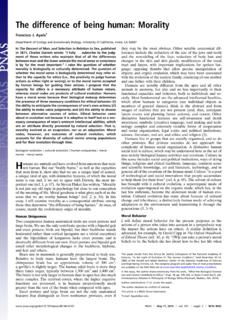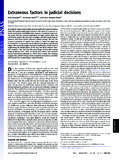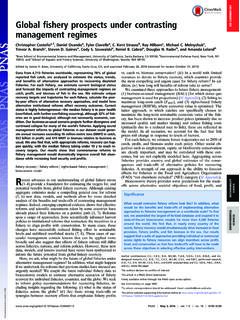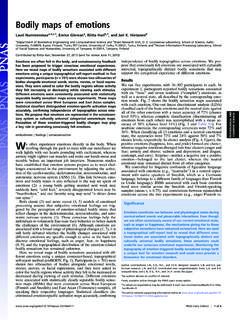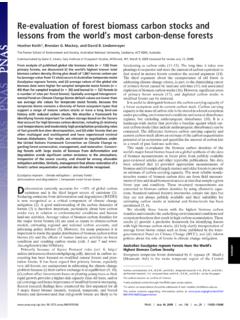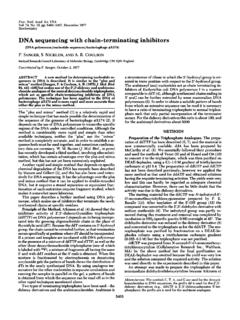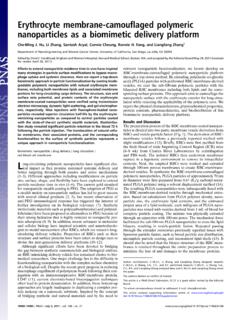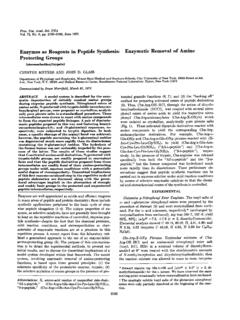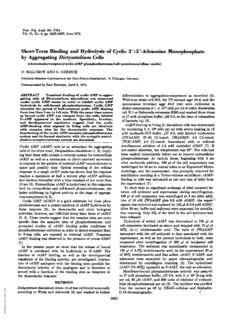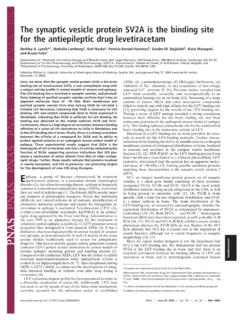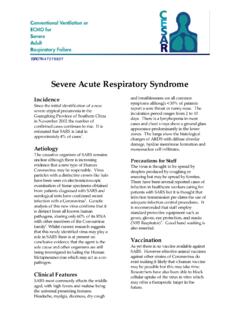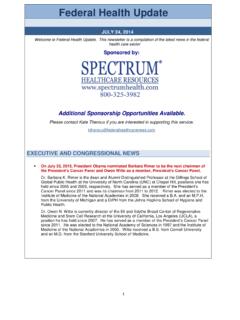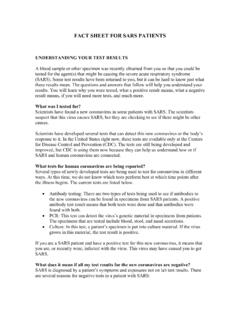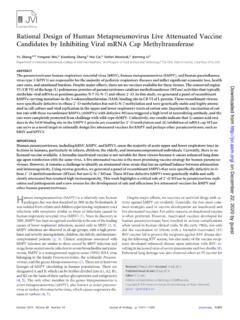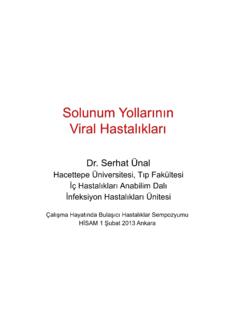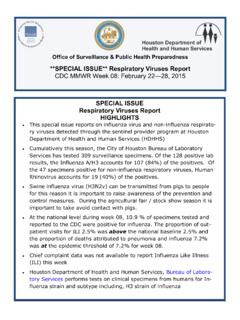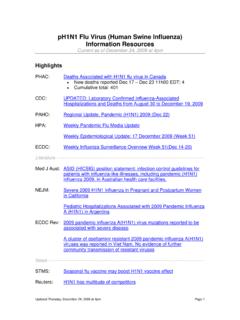Transcription of Integrin v 1 promotes infection by human metapneumovirus
1 Integrin v 1 promotes infectionby human metapneumovirusGabriella Csekea,1, Melissa S. Maginnisb,c,d,1, Reagan G. Coxb,1, Sharon J. Tollefsonc, Amy B. Podsiadc, David W. Wrighta,c,Terence S. Dermodyb,c,d, and John V. Williamsb,c,2aDepartment of Chemistry, Vanderbilt University College of Arts and Sciences, Nashville, TN 37232; and Departments ofbMicrobiology and Immunology andcPediatrics anddElizabeth B. Lamb Center for Pediatric Research, Vanderbilt University School of Medicine, Nashville, TN 37232 Edited by Peter Palese, Mount Sinai School of Medicine, New York, NY, and approved December 15, 2008 (received for review February 14, 2008) human metapneumovirus (hMPV) is a recently described paramyxo-virus that causes lower respiratory infections in children and adultsworldwide.
2 The hMPV fusion (F) protein is a membrane-anchoredglycoprotein and major protective antigen. All hMPV F protein se-quences determined to date contain an Arg-Gly-Asp (RGD) sequence,suggesting that F engages RGD-binding integrins to mediate cellentry. The divalent cation chelator EDTA, which disrupts het-erodimeric Integrin interactions, inhibits infectivity of hMPV but notthe closely related respiratory syncytial virus (RSV), which lacks anRGD motif. Function-blocking antibodies specific for v 1 integrininhibit infectivity of hMPV but not RSV. Transfection of nonpermissivecells with vor 1 cDNAs confers hMPV infectivity, whereas reduc-tion of v and 1 Integrin expression by siRNA inhibits hMPVinfection.
3 Recombinant hMPV F protein binds to cells, whereas Arg-Gly-Glu (RGE)-mutant F protein does not. These data suggest that v 1 Integrin is a functional receptor for paramyxovirus fusion protein viral entryHuman metapneumovirus (hMPV) is a major cause of upperand lower respiratory infections in children and adults(1 3). hMPV is genetically most closely related to respiratorysyncytial virus (RSV), which also is a significant respiratorypathogen of infancy and early childhood (4). hMPV is associatedwith significant morbidity in young infants and other high-riskpopulations with underlying medical conditions such as prema-turity, asthma, cardiopulmonary disease, and immune compro-mise (5).
4 Hospitalization rates for hMPV infection in previouslyhealthy infants or high-risk groups are comparable to thosecaused by other common respiratory viruses such as RSV,parainfluenza virus, or influenza virus (2, 5). There currently isno licensed vaccine or antiviral therapy for this important has a negative-sense, single-stranded RNA genome of 13 kb that encodes 9 proteins (6, 7). Two of these aremembrane-anchored glycoproteins, the fusion (F) and attach-ment (G) proteins. Studies of mutant viruses and recombinantproteins show that F is the major protective antigen (8 10). ThehMPV F protein is similar to other paramyxovirus fusion pro-teins and incorporates homologous regions that likely havehomologous functions (6, 7).
5 Paramyxovirus fusion proteins aresynthesized as inactive precursors (F0) that are cleaved byhost-cell proteases into the fusion-active F1 and F2 F contains a conserved cleavage site, fusion peptide, andheptad-repeat domains. Concordantly, ectopic expression ofhMPV F is sufficient to mediate cell-cell fusion (11). Syntheticpeptides that correspond to the heptad-repeat regions are potentinhibitors of hMPV infection , suggesting that hMPV F is a classI fusion protein (12). Proteinaceous cellular receptors have beenidentified for some paramyxoviruses, including measles virus(13, 14) and Nipah virus (15, 16).
6 Sialylated cell-surface proteinsserve as receptors for other paramyxoviruses, such as parain-fluenza virus (17, 18). For all paramyxoviruses identified to date,the G or H/HN protein rather than the F protein is thereceptor-binding moiety. Receptors for hMPV have not are heterodimeric cell-surface molecules that consistof and subunits (19). Integrins mediate cellular adhesion tothe extracellular matrix, regulate cellular trafficking, and trans-duce both outside-in and inside-out signaling events (19). Inte-grins bind specific ligands in a divalent cation-dependent man-ner, and a subset of integrins bind to specific recognitionsequences such as the amino acid Arg-Gly-Asp (RGD) motif(19).
7 Several viruses use RGD-binding integrins as receptors orco-receptors, including adenovirus (20), echovirus (21), foot-and-mouth disease virus (22), hantavirus (23), human herpesvirus-8 (24), human parechovirus (25), reovirus (26), rotavirus(27), and West Nile virus (28). A role for integrins in infectionby any paramyxovirus has not been this study, we tested the hypothesis that integrins serve asfunctional receptors for hMPV. The divalent cation chelatorEDTA, which reduces Integrin -ligand binding, diminishedhMPV infectivity but had no effect on RSV. Function-blocking v 1 Integrin -specific antibodies inhibited infection by hMPVbut not RSV.
8 Transfection of v 1 cDNA into nonpermissivecells conferred hMPV infectivity. Reduction of v 1 expressionby siRNA diminished hMPV infection . Finally, recombinant Fprotein bound specifically to permissive cells, and mutation ofthe F protein RGD motif abolished this binding. Collectively,these data provide strong evidence that the hMPV F proteinengages v 1 Integrin to mediate functional virus F Contains a Conserved RGD are 4 distinctgenetic lineages of hMPV, provisionally designated A1, A2, B1,and B2 (29). We compared full-length F gene sequences from 71clinical isolates of hMPV collected worldwide over a 20-yearperiod.
9 An RGD motif at residues 329 331, along with 5 N- and16 C-terminal flanking residues, is strictly conserved in allsequences studied, despite diversity in other regions of the Fgene (Fig. S1). This motif, which is predicted to be in asolvent-exposed region of the protein (30) (Fig. 1), is unique tohMPV F among human paramyxovirus fusion proteins andabsent in all published RSV F sequences (data not shown). GivenAuthor contributions: , , , , , and designed research; , , , , and performed research; , , , , , and analyzed data; and , , , , , and wrotethe of interest statement: Dr.
10 Williams has served as a one-time consultant for Med-Immune, article is a PNAS Direct available online through the PNAS open access , , and contributed equally to this whom correspondence should be addressed. E-mail: article contains supporting information online 2009 by The National Academy of Sciences of the USA1566 1571 PNAS February 3, 2009 vol. 106 no. cgi doi by guest on December 22, 2020 the role of RGD sequences in Integrin binding, this finding ledus to hypothesize that integrins function as receptors for and RGD-Specific Peptides Reduce hMPV manycases, Integrin -ligand interactions are dependent on divalentcations, including Ca2 and Mg2 (19).
